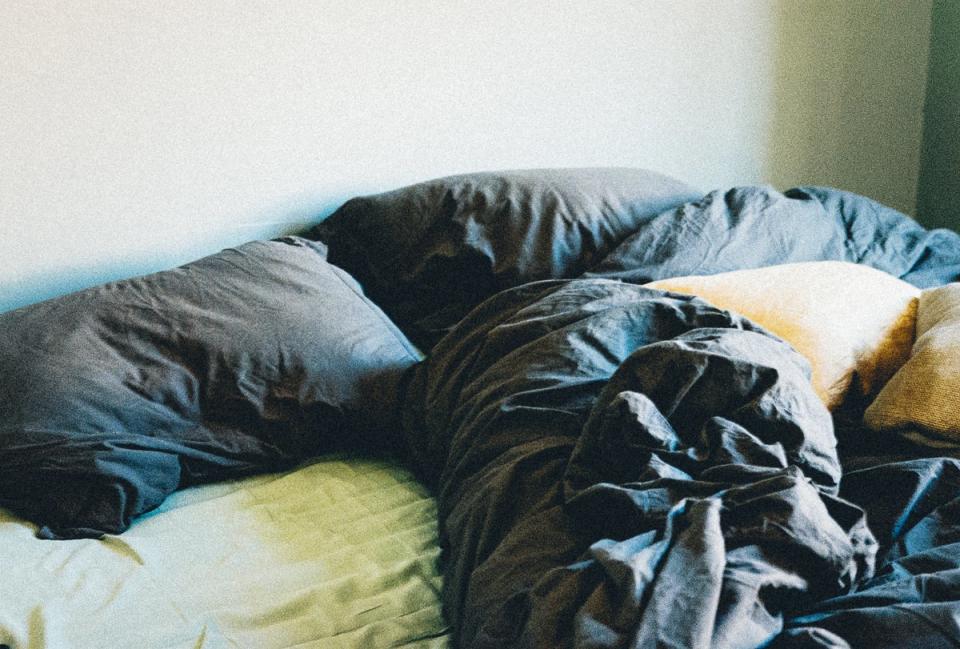Is ‘bed rotting’ the new goblin mode in 2023?

If today’s trends are essentially Gen Z TikTok users giving time-honoured activities new names and making them self-care adjacent, the arrival of “bed rotting” should come as no surprise.
The act of lying under the covers, doing absolutely nothing, has been practised by seasoned slovens including Millennials, Gen X, and Boomers for decades — long before smart phones existed. And that’s all bed rotting is. Doing nothing in bed.
Yes, you can of course scroll, gorge on Selling Sunset, post slices of buttered toast into your face with no regard for escapee crumbs. You can text. Perhaps read an actual paper book but, honestly, the latter I’d argue feels a little high-brow, labour-intensive, for such an activity.
The best bed rotting is where you just sort of, happily, fester. A content languishing — no plans, no promises and, crucially, no guilt or shame. Bed rotting is not about anxiously wigging out in a supine position about all the stuff you should be doing. In this new iteration of taking to your bed for hours on end is a distinct lack of shame.

It’s not skiving or unemployment — you aren’t meant to be in a meeting. You have nothing to hide from your boss (but bed rotting traditionally appals parents). It is, however, a middle finger to hustle culture and an antidote to burnout. It’s not depression — in fact, many argue it’s self care — a means of fortifying one’s mental health.
It can be because of a hangover but it doesn’t have to be. Isn’t this goblin mode,I hear you ask, last year’s Oxford word of the year? Not exactly. While bed rot and goblin mode are absolutely cut from the same cloth, the difference is that bed rot is planned, intentional, and not always wilfully unhygienic. I’d go as far as to say that bed rotting is mindful. It’s a choice. You are quite capable of coping with the world — you’re not hiding from responsibility or commitments — but you don’t fancy it right now and have nothing to prove to anyone. You can bed rot for hours, days, or even a full weekend.
It’s huge on TikTok (there are more than 300 million views of the term bed rotting on the platform). It all kicked off recently, when a user asked: “Who tf actually likes rotting in her bed?” and bed rotters across the globe revealed themselves across social media. “Gen Z is making bed rotting a thing and I finally feel on trend,” said one Twitter user, while another posted selfies from her bed captioned “rotting in bed but make it cute”.
There are, of course, detractors. “It’s just gross,” tweeted one woman while another wrote, “It’s a sign that the ‘kids’ are not alright”. Older generations in particular bray about robust work ethics and pulling socks up, but the truth is that there are Boomer bed rotters, too, and they spent their 20s having a lovely time with their university grants and buying enormous period homes in London, with tiny mortgages, even if they didn’t work in finance. Today’s 20-somethings, however, are staring down the barrel of never being able to own a home as well as navigating a cost-of-living crisis and an epidemic of poor mental health: let them take a break from the daily grind however they please.
Despite its name, bed rot needn’t be disgusting. You can prep for the rotting process: bathing before shrouding yourself in laundry-fresh sheets, say. It can even be a fancy, festive occasion — Diptique candle, anyone?
That being said, it’s important not to wholly glamourise bed rotting. It’s not a permanently ideal state. The trouble with rot is that eventually it sets in. So, what feels like necessary self-care one day can quickly become a way of life if left unchecked. Long live duvet days... in moderation.

 Yahoo Sport
Yahoo Sport 





































